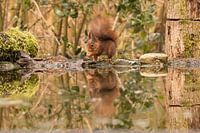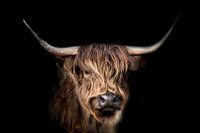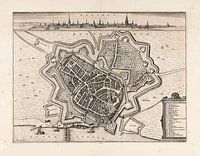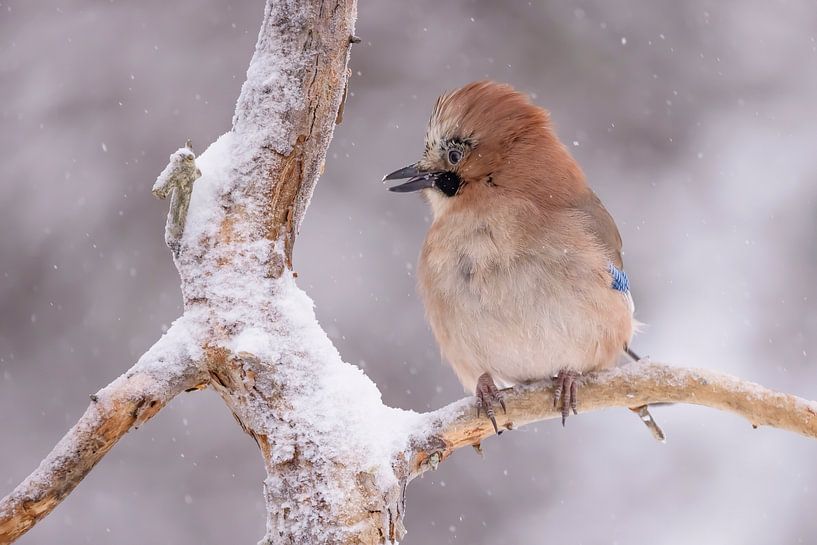Buy this bird art The Jay, also called Jay (Garrulus glandarius) by Gert Hilbink on canvas, ArtFrame, poster and wallpaper, printed on demand in high quality.
About "The Jay, also called Jay (Garrulus glandarius)"
by Gert Hilbink
About the artwork
The jay is 32 to 35 cm long. The nominate form of the bird, which is found in Benelux and elsewhere, is predominantly grey-brown with a pink tinge. The throat, underbelly, anal region, rump and part of the hand pens are white. Characteristic features are a broad black moustache stripe and a blue wing field composed of light blue feathers containing a fine black banding. When excited, the bird may raise its crown feathers, which are alternately light in colour with black. The jay finds food in trees and shrubs, in the air and on the ground; it covers a wide spectrum of animal and plant diet: insects and invertebrates (including many pests), acorns, beechnuts, hazelnuts and other seeds and nuts, fruits such as blackberries, cherries, raspberries and rowan berries. Its diet also includes small or young songbirds and eggs, as well as small rodents. With its strong beak, the jay chops holes in hard shells such as snail shells, nut shells and eggshells, and sweeps through soil, animal droppings and human waste.
The oak depends on the jay to disperse acorns: the jay transports them in its throat and between its beak to places with soft ground, then pushes them into the earth. This is how he builds up a winter supply. He only forgets some places. What is not recovered may grow into a new oak tree. For this reason, the jay is also called 'the greatest forester'. The German name for the jay (Eichelhäher) typifies its behaviour. The scientific name Garrulus glandarius translates freely as constantly scratching acorn seeker.(Garrulus glandarius)

About Gert Hilbink
Hello, nice that you take a look in my shop. So my name is Gert Hilbink, living in Coevorden. I have been doing photography since I was 13, inspired by a biology teacher at the then U.L.O. school in Coevorden. Generally I mainly photograph nature but actually.. Read more…
 Netherlands
Netherlands Ordered in April 2020
Ordered in April 2020
 Germany
Germany Ordered in May 2022
Ordered in May 2022
 Germany
Germany Ordered in September 2019
Ordered in September 2019
 Netherlands
Netherlands Ordered in September 2022
Ordered in September 2022
 Netherlands
Netherlands Ordered in May 2021
Ordered in May 2021
 Germany
Germany Ordered in February 2023
Ordered in February 2023
 Netherlands
Netherlands Ordered in June 2023
Ordered in June 2023
 Germany
Germany Ordered in May 2021
Ordered in May 2021
 Germany
Germany Ordered in October 2019
Ordered in October 2019
 Netherlands
Netherlands Ordered in March 2024
Ordered in March 2024
 Germany
Germany Ordered in July 2020
Ordered in July 2020
 Germany
Germany Ordered in November 2024
Ordered in November 2024
About the material
ArtFrame™
Interchangeable Art Prints
- High-quality print
- Easily interchangeable
- Acoustic function
- Large sizes available
Discover the artworks of Gert Hilbink
 Frysian HorsesGert Hilbink
Frysian HorsesGert Hilbink SquirrelGert Hilbink
SquirrelGert Hilbink Oil on water, colorful surfaceGert Hilbink
Oil on water, colorful surfaceGert Hilbink F-16 Fighting FalconGert Hilbink
F-16 Fighting FalconGert Hilbink F-16 Fighting FalconGert Hilbink
F-16 Fighting FalconGert Hilbink F-16 Fighting FalconGert Hilbink
F-16 Fighting FalconGert Hilbink F-16 Fighting FalconGert Hilbink
F-16 Fighting FalconGert Hilbink F-16 Fighting Falcon, take off.Gert Hilbink
F-16 Fighting Falcon, take off.Gert Hilbink Scottish HighlanderGert Hilbink
Scottish HighlanderGert Hilbink Scottish HighlandersGert Hilbink
Scottish HighlandersGert Hilbink Canyons in America, Antelope CanyonGert Hilbink
Canyons in America, Antelope CanyonGert Hilbink Canyons in Amerika, Antelope CanyonGert Hilbink
Canyons in Amerika, Antelope CanyonGert Hilbink The Fifth of Beethoven, Ludwig van BeethovenGert Hilbink
The Fifth of Beethoven, Ludwig van BeethovenGert Hilbink KLM Boeing 747-400M, PH-BFV. City of VancouverGert Hilbink
KLM Boeing 747-400M, PH-BFV. City of VancouverGert Hilbink Porsche 911 Carrera, with text whiteGert Hilbink
Porsche 911 Carrera, with text whiteGert Hilbink Porsche 911 Carrera 4S, sports car.Gert Hilbink
Porsche 911 Carrera 4S, sports car.Gert Hilbink Porsche 911 Carrera 4S, sports car.Gert Hilbink
Porsche 911 Carrera 4S, sports car.Gert Hilbink Map of Zutphen, circa 1650, with white frame.Gert Hilbink
Map of Zutphen, circa 1650, with white frame.Gert Hilbink Porsche 911 Turbo SGert Hilbink
Porsche 911 Turbo SGert Hilbink F-16 Fighting FalconGert Hilbink
F-16 Fighting FalconGert Hilbink













 Autumn
Autumn Birds
Birds Nature photography
Nature photography Photo wallpaper
Photo wallpaper Photography
Photography Serene Peace
Serene Peace Snow
Snow Winter
Winter









